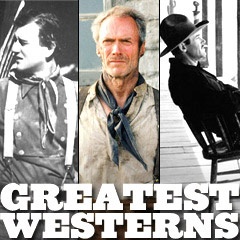
|
Greatest Westerns 1960-1965 |
| Film Title/Year/Director/Length/Studio, Setting (or Time Period) and Brief Description | |
Comanche Station (1960)
Randolph Scott once again worked with director Budd Boetticher - but this was the last of their western collaborations. The old-fashioned, pessimistic oater told of stoic, forlorn loner Jefferson Cody (Randolph Scott) during a heroic yet private, obsessive rescue mission. He had been searching for 10 years for his captive kidnapped wife, taken by Comanches. After bartering his Winchester rifle and $5 worth of traded goods for a female captive, he realized that the abductee wasn't his wife, but a red-headed, married white woman named Nancy Lowe (Nancy Gates). Thinking he had mercenary motives, she didn't believe him when he told her that he didn't know about the bounty on her head - a dead-or-alive $5,000 reward offered by her husband. On his way to return her to her hometown of Lordsburg, he met up at Comanche Station with a trio of bounty-hunting outlaws: Dobie (Richard Rust), Frank (Skip Homeier) and their greedy leader Ben Lane (Claude Akins) (with whom Cody had a past rivalry). The mercenary group's malevolent intent was to claim her for the dead or alive $5,000 reward. The unscrupulous Lane was planning to kill both Nancy and Cody to claim the money. After skirmishes with Comanches and a final shootout with Lane, Cody safely delivered Nancy to her young son and husband (revealed to be blind). He turned and rode away before accepting the reward money. |
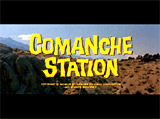
|
The Magnificent Seven (1960)
A westernized remake of Japanese director Akira Kurosawa's Seven Samurai (1954, Jp.), and with a memorable score by Elmer Bernstein. The box-office "feel-good" hit inspired three sequels (1966, 1969, and 1972) and a late 1990s TV series. The ensemble film involved seven gunslingers who served as a vigilante force to protect a terrorized Mexican town and its oppressed peasant villagers from invading bandits, led by gold-toothed Calvera (Eli Wallach). The seven in the low-paid group of misfit, mercenary gunmen included Yul Brynner (as reluctant black-clad leader Chris Adams), Steve McQueen (as easy-going gambler/drifter Vin Tanner), Charles Bronson (as Irish-Mexican Bernardo O'Reilly), James Coburn (as knife-throwing, cowpuncher Britt), Robert Vaughn (as fugitive gunman Lee), Horst Buchholz (as young and hot-tempered Chico) and Brad Dexter (as greedy Harry Luck). After the climactic shootout, only three of the seven were left -- Chico, Chris, and Vin, and the film concluded with Chris' pessimistic words: "The Old Man was right. Only the farmers won. We lost. We always lose." |

|
The Unforgiven (1960)
An intriguing social conscience western about racial injustice, with an anti-racist stance although often criticized for its stereotypical depiction of Indians. Director Huston's film can be compared to its counterpoint - Ford's The Searchers (1956). The film opened with adopted young Rachel Zachary (Audrey Hepburn) galloping on the open range, when she was startled and frightened by an elderly strange man in a tattered Union uniform lifting his saber, declaring she was "no Zachary," and shouting vengefully "I am the sword of God." Rachel's mother, Texas panhandler-settler Mattilda (Lillian Gish) shot at the man and chased him off. She lived in the Zachary family with three brothers who were just returning from a cattle drive: patriarchal Ben Zachary (Burt Lancaster), bigoted and violent Indian-hater Cash (Audie Murphy) and virginal good-guy Andy (Doug McClure). The haggard and demented man was revealed to be Bible-quoting, one-eyed Abe Kelsey (Joseph Wiseman), who had good reason to be an Indian-hater, and to suspect and spread rumors that Rachel had Indian blood and had been raised by the Zacharys from infancy. Indians had killed Kelsey's son and later killed Mattilda's pacifist, compassionate husband Will, who had managed to save Rachel as a baby - the only survivor of a slaughtered Kiowa camp. Tensions heated up after two incidents: Rachel's Kiowa brother Lost Bird (Carlos Rivas) came to return her to her native people in exchange for horses, and the Kiowa murder of Charlie Rawlins (Albert Salmi), the son of Ben Zachary's ranching partner Rev. Zeb Rawlins (Charles Bickford) and also Rachel's suitor-boyfriend. As a result, local whites turned against Rachel and ostracized her adoptive family (even Cash disowned his own adopted sister), and they were forced to defend themselves on their own from a ferocious Indian attack on the Zachary homestead. Many criticized the commercial, typical, Hollywoodized, incongruent "action-packed" ending (the Zacharys killed dozens of Kiowa, with Cash arriving for a last-minute rescue). At the end of the assault which left Mattilda mortally wounded, Rachel shot Lost Bird dead. |

|
The Comancheros (1961)
Famed veteran director Michael Curtiz' last film. Comancheros in the title referred to white renegade traders and Mexicans who were selling guns and whiskey to the marauding Comanches in early Texas. Texas Ranger Capt. Jake Cutter (John Wayne) (aka Big Jake, although not related to his character in Wayne's later movie, Big Jake (1971)) tracked down and arrested Louisiana gambler/duellist and womanizer "Monsieur" Paul Regret (Stuart Whitman). While bringing him (through extradition) to Louisiana to hang for killing Emil Bouvier (Gregg Palmer), the son of a Louisiana judge in a pistol duel in New Orleans, Regret escaped as a fugitive, but was recaptured. Jake also encountered surly, half-scalped, liquor-swilling Tully Crow (Lee Marvin), a Comanchero agent. Jake was ordered to go after the Comancheros, by impersonating a gun smuggler. Out of necessity, Jake had to team up with Regret to defeat the band of renegade arms merchants and thieves, led by older, refined and crippled Mexican warlord Graille (Nehemiah Persoff) with a bandit Comanchero stronghold in the American desert (his character was similar to a Bond villain). In a romantic side-plot, Regret had a tryst with the ruthless leader's daughter Pilar Graille (Ina Balin), who eventually helped Regret and Jake escape capture and sabotage her father's stronghold before they were rescued by the Texas Rangers during a concluding shootout. |
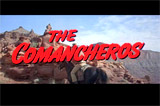
|
One-Eyed Jacks (1961)
This ragged, overlong, brooding revenge western was directed by its own star Marlon Brando, his sole directorial effort. It was a version of the "Billy the Kid" legend. Originally an excessive four-hour epic, it was edited down. It opened with two bank robbers, Rio or "The Kid" (Marlon Brando) and his pal Dad Longworth (Karl Malden), fleeing from the Rurales in the Mexican mountainside. When Rio's horse was shot out from under him, Longworth promised to find another horse and return, but he betrayed him and absconded with the gold loot in saddle bags - and Rio was caught and imprisoned in Sonora for five years. After escaping with cellmate Chico Modesto (Larry Duran), Rio went on a vengeful vendetta against Longworth, who had settled down as the elected sheriff of Monterey (in California), and had married a Mexican woman - Maria 'Mother' (Katy Jurado) with a daughter. His plan was to join with two other outlaws, Bob Amory (Ben Johnson) and Harvey Johnson (Sam Gilman), rob the Monterey bank, and seduce and shame Longworth's virginal teenaged step-daughter Louisa (Pina Pellicer) (she ended up with an unwed pregnancy). However, as it turned out, after Rio killed (in self-defense) a drunken and abusive saloon patron in town, Longworth got even. He publically whipped Rio, smashed and injured his shooting hand, and drove him away. And then Rio was blamed for the bank heist (and a murder), imprisoned, and about to be hanged. Louisa helped Rio to escape from jail and Longworth's sadistic deputy Lon (Slim Pickens), after which in a predictable shootout, Rio gunned down his long-time enemy Longworth in the back. |

|
Two Rode Together (1961)
A minor western from John Ford about racism, slightly similar to The Searchers (1956), about two men who "rode together" on a mission. In the 1880's, cynical, opportunistic mercenary Texas Marshal Guthrie McCabe (James Stewart) accepted orders to join cavalry officer First Lt. Jim Gary (Richard Widmark) in relieving the grief of despondent relatives by rescuing, bringing home, and repatriating a long-lost group of white settlers who had been abducted and held captive by the Comanches. McCabe agreed due to Army pressure and the promise of a lucrative $500 payment per captive by Army Major Fraser (John McIntire), and secondarily so that he could escape marriage-minded, co-saloon-brothel owner and attractive yet coarse-talking fiancee Madam Belle Aragon (Annelle Hayes). During a memorable 4-minute river bank sequence - a long uninterrupted take between Marshal McCabe and Lt. Jim Gary, the two sat down on a log, rinsed off their faces, smoked cigars, and bantered realistically about McCabe's fiancee (who carried a stiletto in her garter belt); she was hinting at matrimony by suggesting increasing his take of saloon profits: ("...she didn't see why I was satisfied with just 10 percent of her take when she was willing to go for fifty-fifty...I get 10 percent of everything in Tascosa"); McCabe argued that he was justified with the extra money since the Marshal's salary was only $100 dollars a month -- "Look at you. Jim, Jim. You're a man of simple wants. I just require a little more, that's all." McCabe and Gary traded two rifles for two of the Indian captives in a deal made with Chief Quanah Parker (Henry Brandon): (1) Running Wolf (David Kent), a white boy raised as an Indian - and later revealed to be Steve, the abducted brother of tomboyish white settler Marty Purcell (Shirley Jones) - Lt. Gary's love interest and fiancee, and (2) Elena de la Madriaga (Linda Cristal), a beautiful young Mexican woman - the forced squaw named Wah-kay-nah of warring Comanche Stone Calf (Woody Strode) for five years. After they departed from the Indian camp, Stone Calf (in full headdress garb) appeared at McCabe's camp site with a knife and tried to reclaim Elena, and McCabe shot him dead. When they returned to Fort Grant and civilization with the two released captives, there were ugly issues to face from racist fort-dwellers. Elena was particularly shunned by the hypocritical white society, especially the wives ("These people, they smile at me and show their teeth, but it's the eyes that bite"). Mentally-deranged and hysterical Mrs. McCandless (Jeanette Nolan) wrongly claimed that savage 17 year-old Running Wolf was her lost son - and he shockingly stabbed her through the heart (off-screen) when she released his bonds and tried to cut his braided hair. In retaliation, the settlers proceeded to lynch the youth - and as the execution was about to be committed, his true heritage was revealed (he recognized his toy music box and spoke out: "Mine!" but he was taken away to his death). In the conclusion, McCabe was leaving to return to his Texas marshal's job, but he changed his mind (he learned his position had been filled in his absence by his deputy). He bid farewell to Lt. Gary and Belle in the saloon, and joined Elena to go to California, riding shot-gun on her stagecoach (Lt. Gary spoke to Belle about McCabe's decision in the film's final lines - Belle: "You'd think a woman with my experience would know more about men" Lt. Gary: "Yeah. Well, I guess old Guth finally found somethin' he wanted more than ten percent of") |

|
How the West Was Won (1962)
A five part Western travelogue epic (narrated by Spencer Tracy) with an all-star cast about three generations of pioneers, filmed in the short-lived super-widescreen Cinerama format. The five sections were: (1) THE RIVERS, (2) THE PLAINS, (3) THE CIVIL WAR, (4) THE RAILROAD, (5) THE OUTLAWS. The film opened in 1829, with Zebulon Prescott (Karl Malden) journeying with his four children and his wife Rebecca (Agnes Moorehead) from his New England farm westward to Ohio via the Erie Canal and down the Ohio River on a raft. Along the way, they met backwoods fur trapper Linus Rawlings (James Stewart), who soon after rescued the Prescotts from river pirates led by Colonel Hawkins (Walter Brennan). Afterwards, two of the Prescott children drowned in the rapids, and Linus married Eve (Carroll Baker). In St. Louis, daughter Lilith Prescott (Debbie Reynolds), now working in a dance hall, impressed hustling gambler Cleve Van Valen (Gregory Peck), who joined her on a westward trek to California, to opportunistically locate her inherited gold mine - discovered to be worthless. After marriage, they settled in San Francisco. The plot returned to widowed Eve (Linus died in a Civil War battle), whose eldest farm boy son Zeb Rawlings (George Peppard) joined the Union troops, and was fortuitously present to save Generals Sherman (John Wayne) and Grant (Henry "Harry" Morgan) from being assassinated during the Battle of Shiloh by Confederate-Reb deserter (Russ Tamblyn). After the war, when Zeb found that his mother had died, he joined the US Cavalry to protect railroad construction workers and keep peace with the Indians, assisted by grizzly buffalo hunter Jethro Stuart (Henry Fonda). The peace was short-lived when Union Pacific RR foreman Mike King (Richard Widmark) broke the Arapaho Indian treaty by cutting through Indian territory, and the Indians retaliated. Disheartened, Zeb Rawlings resigned and went to Arizona, where he became a Marshal and married Julie (Carolyn Jones) and had children. They were visited by Zeb's aunt - widowed and impoverished Lilith who had moved from Nob Hill to Arizona. Zeb pursued outlaw gang leader Charlie Gant (Eli Wallach), intent on robbing a train's gold shipment, and was able to kill his adversary during the exciting runaway train sequence. |

|
The Man Who Shot Liberty Valance (1962)
Another pairing of the duo of John Ford (with his last great film) and frequent star John Wayne, who was noted for repeatedly calling his co-star James Stewart "Pilgrim." It was a re-examination of Western myth told in a classic western that starred John Wayne (as respected rancher and gunslinger Tom Doniphon), James Stewart (as transplanted pacifist tenderfoot and novice Easterner attorney at law Ransom "Ranse" Stoddard), Lee Marvin (as drunken and villainous outlaw Liberty Valance), Vera Miles (as young waitress Hallie), and Woody Strode (as Doniphon's black farmhand Pompey). The film opened with a lengthy flashback told by US Senator Ranse Stoddard describing his bullying by menacing and ruthless Liberty Valance 25 years earlier in Shinbone. Their conflict eventually led to a challenge-duel on a dark street - won surprisingly by a wounded Stoddard who forced to shoot with his left-hand. He was declared a hero ("The Man Who Shot Liberty Valance') for the remainder of his life, even though he had learned a few weeks later that he hadn't killed Valance. The real truth was privately told by Doniphon to Stoddard, who claimed he was hiding and had fired the fatal shot from a side street. The words: "This is the West, sir. When the legend becomes fact, print the legend," added another layer of meaning. The heroic, self-sacrificing Doniphon lost the love of his life Hallie to Stoddard, and died a drunken and disconsolate man - with a burned-down house he had planned to live in with her. |
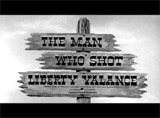
|
Ride the High Country (1962)
An elegiac end-of-an-era western always noted as the valedictory 'swan song' for iconic genre actors Randolph Scott and Joel McCrea, both veteran lawmen in many iconic westerns. Aging, law-abiding ex-marshal Steve Judd (Joel McCrea) arrived in town (the modern era was signaled by automobiles) to take a dangerous new position, as a $250,000 gold-deposit guard during transport from the mountain claims in the high country to the bank in Hornitos, California - a three day's journey each way. He hired old friend Gil Westrum (Randolph Scott), first seen looking like Buffalo Bill at a traveling carnival where he was bragging about his past as "The Oregon Kid" sharpshooter. Another of the hired guards was womanizing, reckless gunslinger Heck Longtree (Ron Starr), Westrum's hot-headed, womanizing sidekick. The two old heroes were joined by rebellious farmgirl Elsa Knudsen (Mariette Hartley in her film debut). She wished to leave her demanding, repressive and puritanical father Joshua Knudsen (R. G. Armstrong) to elope and join up with her fiancee, miner Billy Hammond (James Drury) in remote Coarse Gold. There were potential issues: Elsa flirted with Heck during the trip, and Hammond had a number of drunken, no-good brothers (including menacing Henry Hammond (Warren Oates)) who also wished to share the new bride. After Elsa was married (with the ceremony dissolving into a brawl), she was rescued by the group, and they intended to return her to her farmhouse on the way back. Double-crossing Westrum (with Heck) plotted to steal the gold shipment, complicating matters when the group was ambushed by the five Hammonds in pursuit, and Judd was forced to reluctantly join forces with Westrum and Heck to fight off the group. The film ended with a classic, open face-to-face shootout at Elsa's farmhouse between the group and the three surviving Hammonds. Although all of the Hammonds were eliminated, Judd was mortally wounded, and asked that he die in private, without Heck or Elsa (now a couple) nearby: ("I don't want them to see this. I'll go it alone"); after Westrum pledged to follow Judd's wishes and deliver the gold: ("Don't worry about anything. I'll take care of it, just like you would have"), Judd replied: ("Hell, I know that. I always did. You just forgot it for a while, that's all"); Judd's final words were: "So long partner" - Westrum stood and replied (off-camera): "I'll see ya later", then turned and walked off; Judd gazed at the faraway high-country mountains in the background, and then as he collapsed and slumped to his left onto the ground, he died (off-camera). |

|
A Fistful of Dollars (1964, It.)
(aka Per un Pugno di Dollari)
The first low-budget "spaghetti western" classic from Sergio Leone, filmed in Spain, with a script based on Akira Kurosawa's Yojimbo (1961, Jp.). Clint Eastwood starred as the iconic, brooding, squinty-eyed, nameless, enigmatic gunslinger ("The Man With No Name" yet referred to once as Joe), involved in an uneasy feud between two warring factions - the Rojo and the Baxter families. The film opened with the bearded, cigar-smoking, poncho-wearing lone cowboy (Eastwood) riding on a mule into San Miguel, a border town, where he firsthand learned about the ongoing rivalry between the two clans, both involved in contraband whiskey and guns. The amoral and opportunistic stranger, sensing a "fistful of dollars" to be made, first shot at four of the Baxter hired guns, then offered to work for the Rojos. Playing both sides, he stoked and intensified the hatred between the families (while not revealing his true allegiance). However, after helping imprisoned hostage Marisol (Marianne Koch) to escape from the Rojos and reunite with her family, patriarch Ramon Rojo (Gian Maria Volonté) was incensed and brutally tortured and maimed the "Man with No Name." While recovering in an abandoned mine, Ramon killed the entire Baxter family and burned their house down. After recovering, the cunning stranger returned to town for a final showdown with the Rojo clan and killed all of them, before leaving the town on his mule (and riding off with gold stolen by the Rojos from a Mexican cavalry unit). |
 
|
Cat Ballou (1965)
A wild western parody, acclaimed for Lee Marvin's Oscar-winning double role, and with musical interludes from balladeers Nat King Cole and Stubby Kaye. The film's title character, aspiring school teacher Catherine Ballou (Jane Fonda), was returning to her father Frankie Ballou's (John Marley) ranch in Wolf City, Wyoming by train, after completing an Eastern finishing school. Although appearing prim and proper, she was secretly reading a western pulp about legendary and notorious outlaw Kid Shelleen. Enroute, she aided the escape of handsome accused cattle rustler Clay Boone (Michael Callan) from Sheriff Maledon (Bruce Cabot), when Boone's drunken Uncle Jed (Dwayne Hickman) disguised as a preacher distracted the lawman. At the ranch, she learned that her father was being pressured and threatened with death by the Wolf City Developing Company (WCDC) - they wanted him to sell his ranch to them for its watering rights. Educated Indian ranch-hand Jackson Two-Bears (Tom Nardini) seemed to be the only one to defend Frankie. After fast-draw hired killer Tim Strawn (aka Silvernose) (Lee Marvin) murdered her father, Catherine sought ineffectual help from the two escaped outlaw-cons (Clay and Jed) from the train, and then enlisted gunslinger Kid Shelleen (Lee Marvin) for $50 to seek revenge. When Shelleen appeared, he was hopelessly drunk and unable to shoot, so Catherine decided to seek vengeance herself as "Cat" Ballou. With a gang of associates, she robbed a train that was carrying the Wolf City payroll, using the Kid's robbery plan written about in the dime novel. When Shelleen sobered up - partially because of his unrequited love for Cat, he killed his own twin brother Strawn. Cat went after WCDC town boss Sir Harry Percival (Reginald Denny) - masquerading as a prostitute promising sex - and killed him. Although sentenced to be hanged, Cat's gang arrived for a daring rescue and escape. |
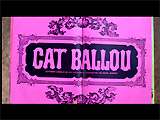
|
For a Few Dollars More (1965,
It.) (aka Per Qualche Dollaro in Più)
The second low-budget "spaghetti western" classic from Sergio Leone - a violent vigilante western with stylistic violence and again Ennio Morricone's soundtrack. The film opened with the appearance of two cunning bounty hunters in El Paso, Texas: (1) a laconic stranger or "The Man With No Name" (referred to as Manko) (Clint Eastwood), and (2) vengeful ex-Confederate Army officer Colonel Douglas Mortimer (Lee Van Cleef). They begrudgingly decided to team up and together split the $10,000 reward/bounty for the capture of sadistic and maniacal outlaw El Indio (Gian Maria Volonte). (Later in the film, it was learned that Indio had raped Mortimer's sister (Rosemarie Dexter), causing her to commit suicide.) Their strategy was to first win favor with Indio - so they orchestrated a jailbreak to free him, and then joined his gang to rob the El Paso Bank. The two distrustful, wary bounty hunters acquired the safe stolen from the bank and hid the money inside, but then Indio captured them. However, by the film's bloody conclusion, only Mortimer and the stranger were alive, and Mortimer had avenged his sister's death. Mortimer let the stranger collect the bounty by himself. |
 
|
(chronological by film title) Introduction | Silents-1930s | 1940s | 1950-1955 | 1956-1959 | 1960-1965 1966-1969 | 1970s | 1980s-1990s | 2000s | 2010s |